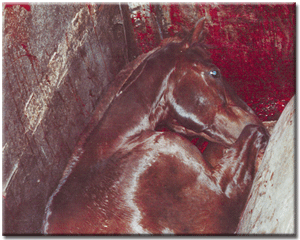Obama signs law legalizing horse slaughter in the US

PETITIONS AND ACTIONS BELOW
FROM: THE PERSIAN HORSE’S BLOG
Last week while you weren’t looking Congress and the president did something the vast majority of Americans oppose. The president signed an omnibus-spending bill approved by Congress that makes it legal to slaughter horses in the United States once again. Polls show more than 70 percent of Americans oppose horse slaughter and few if any eat horse meat. Given the fact we are divided politically by a gap the size of the Grand Canyon, recognize that a 70 percent majority is an unheard of amount of backing.
But wait, it gets worse. The reintroduction of horse slaughter plants in the United States comes with a hefty price tag, much of which goes to line the pockets of people in other countries who own these dens of incalculable abuse. The way it works is that ever since 2005, there has been a section of the Agriculture appropriations bill that de-funds (to wit, bars the expenditure of taxpayers’ dollars on) a program for the USDA to inspect foreign-owned horse plants. Now that the de-funding law has been deleted, supporters of the grisly, completely inhumane process of horse slaughter will go back to lobbying Congress for millions of dollars annually to run the inspection program. Without inspection, it is illegal to transport horsemeat across state lines. Once they succeed, horse slaughter will resume here.
Let’s forget for the moment that candidate Barack Obama in 2008 pledged to keep the ban on horse slaughter permanent (another promise to voters reneged?) Let’s forget, too, that American horses are not bred or raised for consumption. Let’s forget that the few countries where horsemeat is consumed (France, Belgium and Japan among them) are ignoring the outright cruelty to horses that raises the hackles of right-thinking Americans. The simple question is: do we want our tax dollars spent to inspect horses who were slaughtered in incredibly cruel fashion (a bolt through the forehead that doesn’t kill them immediately) so foreign owners of slaughter plants can profit? In the midst of a recession when other crucial programs such as Medicare and education are suffering deep cuts, the answer is a resounding, “no.”
Supporters of horse slaughter say the reintroduction of slaughter plants in the U.S. will create jobs. An article in the Desert Independent in Blythe, Calif., this month noted, “Horse slaughter plants operating until 2007…never created a total of more than 178 jobs.” The kind of jobs they do create are of dubious economic value to the individuals who take them and to the communities where slaughter plants are located.
The Independent quotes Paula Bacon, former mayor of Kaufman, Texas, where a horse slaughter facility operated for years as saying, “Horse slaughter means very few, very low wage jobs, meaning workers and their families overtaxed local resources like the hospitals and government services. This so called business brought in virtually no tax revenues and local governments incurred substantial enforcement costs in trying to regulate these facilities. The standard of living dropped during the time horse slaughter facilities operated. Having a horse slaughter facility drove away good businesses.”
Studies have shown that when slaughter plants are opened in rural areas, violent crime quickly rises. Think about it. Horses are sometimes cut into pieces while still alive and screaming. What kind of person would accept the minimum wage to engage in this horrific behavior? The question answers itself.
Rep. Jim Moran, D-Va., sponsored the de-funding amendment in the House version of the Agriculture Appropriations bill. He said he regrets voting for the overall bill (which did not include the de-funding language) but felt compelled to do so, to keep the government operating. He said the only alternative is to assure passage of a permanent ban on horse slaughter, which he and other compassionate members of Congress are working to do. Let’s wish them success.
PLEASE SIGN THESE TWO PETITIONS:
Overturn Obama’s Legalization of Horse Slaughter for Human Consumption
Slaughter/Consumption of Horses – Un-American!
IF YOU ARE AS DISGUSTED AND ENRAGED AS THE PERSIAN HORSE IS OVER THIS BLATANT and TREACHEROUS CORRUPTION, YOU MAY TAKE THE FOLLOWING ACTIONS:
- CLICK HERE TO SEND YOUR MESSAGE OF DISGUST AND DISAPPOINTMENT TO PRESIDENT OBAMA.
- CLICK HERE TO SEND A MESSAGE TO YOUR REPRESENTATIVES. Type In Your Zip Code
- CLICK HERE TO SEND THE ABOVE ALERT TO HUNDREDS OF MEDIA OUTLETS. (Hint: send this link to the Media outlets: http://www.scrippsnews.com/node/65615 )
- CLICK HERE TO FIND FEDERAL REPRESENTATIVES’ FAX NUMBERS
- CLICK HERE TO SEND FREE FAXES FROM YOUR COMPUTER. (Hint: Your Tax Dollars Pay for the Fax Paper),

 There's still room for upward hay-price movement despite the fact that dairy hay prices have gone through the roof in California this year, says Norman Beach, vice-president of the San Joaquin Valley Hay Growers Association in Tracy, CA.
There's still room for upward hay-price movement despite the fact that dairy hay prices have gone through the roof in California this year, says Norman Beach, vice-president of the San Joaquin Valley Hay Growers Association in Tracy, CA.